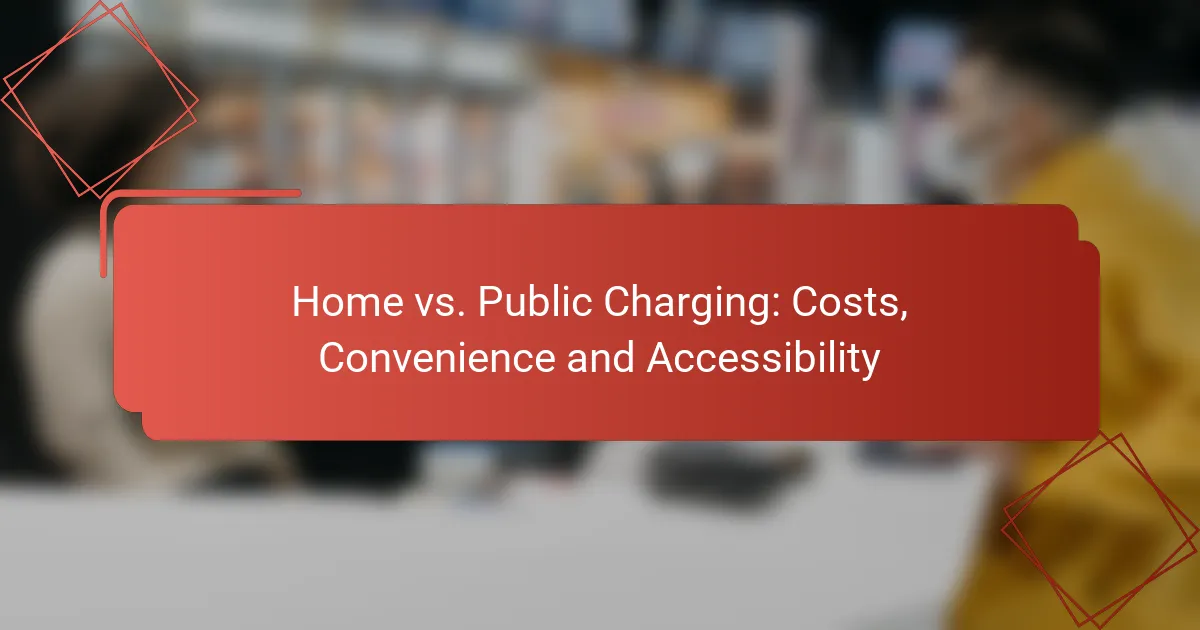When considering electric vehicle charging options, understanding the differences between home and public charging is essential. Home charging typically offers lower costs and greater convenience, while public charging can present challenges such as planning and potential wait times. Additionally, accessibility varies based on factors like property ownership and local infrastructure, influencing the overall charging experience for EV owners.
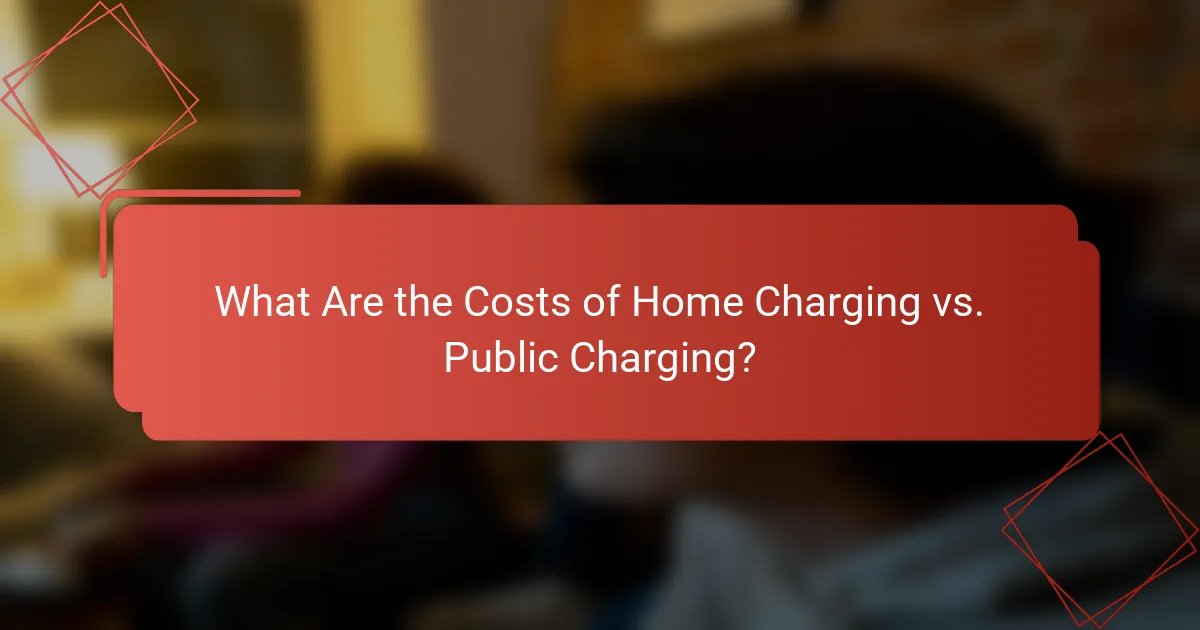
What Are the Costs of Home Charging vs. Public Charging?
The costs of home charging are generally lower than those of public charging, but this can vary based on location and charging network. Understanding the differences in expenses and convenience can help you make informed decisions about your electric vehicle charging options.
Home charging costs are lower
Charging your electric vehicle at home typically costs less than using public charging stations. Home electricity rates are often more stable and predictable, averaging around $0.10 to $0.20 per kWh in the U.S. This means that charging overnight can be particularly economical, especially if you take advantage of lower off-peak rates.
Additionally, many homeowners can install a Level 2 charger, which allows for faster charging times and can be more cost-effective in the long run. The initial investment in equipment may be offset by the savings on electricity over time.
Public charging costs vary by location
The cost of public charging can fluctuate significantly based on geographic location and the type of charging station. Urban areas may have higher rates due to demand, while rural locations might offer lower prices. Charging fees can range from free to over $0.50 per kWh, depending on the provider and the charging speed.
Some public chargers also implement a pay-per-minute model, which can lead to higher costs if you are using slower charging stations. Always check the pricing structure before charging to avoid unexpected expenses.
Cost comparison of charging networks
Different charging networks have varying pricing structures and membership options. Major networks like ChargePoint, Electrify America, and EVgo may charge differently based on factors such as location, speed of charging, and whether you are a member. For instance, membership can sometimes reduce per-kWh costs or provide access to exclusive discounts.
It’s beneficial to compare these networks based on your typical routes and charging needs. Some networks may offer flat-rate charging, while others might charge based on usage, so consider your driving habits when selecting a network.
Potential savings with home charging
Home charging can lead to substantial savings over time, especially for daily commuters. By charging at home, you can avoid the higher costs associated with public charging and take advantage of lower electricity rates. This can translate to savings of hundreds of dollars annually, depending on your driving habits and local electricity prices.
Moreover, many utility companies offer incentives for electric vehicle owners, such as rebates for home charger installation or reduced rates during off-peak hours, further enhancing the cost-effectiveness of home charging.
Subscription plans for public charging
Some public charging networks offer subscription plans that can help reduce costs for frequent users. These plans typically involve a monthly fee in exchange for lower per-kWh rates or unlimited charging access. For regular users, this can be a cost-effective option compared to pay-as-you-go pricing.
Before committing to a subscription, evaluate your charging habits and calculate whether the plan aligns with your needs. Consider factors like how often you charge in public and the average costs of your typical charging sessions to determine if a subscription is worthwhile.
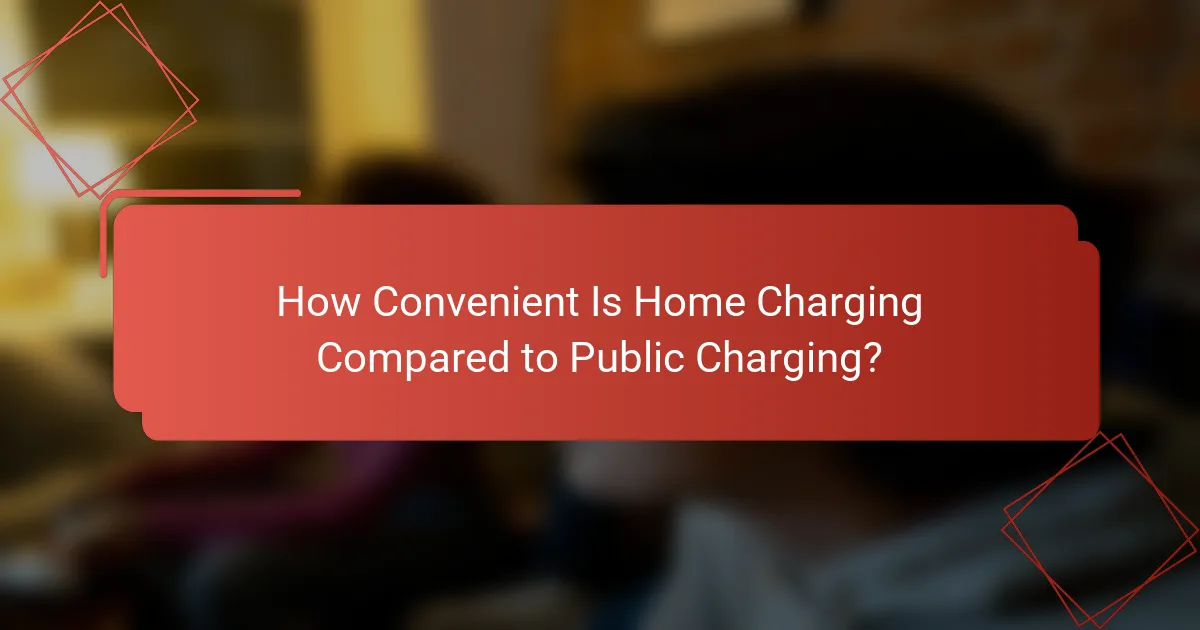
How Convenient Is Home Charging Compared to Public Charging?
Home charging is generally more convenient than public charging due to its constant availability and ease of access. While public charging can be useful, it often requires planning and can involve longer wait times.
Home charging offers 24/7 availability
Home charging allows electric vehicle (EV) owners to charge their cars at any time, day or night. This flexibility means you can plug in your vehicle overnight and start each day with a full battery, eliminating the need to find a charging station during busy hours.
By charging at home, you can avoid the hassle of scheduling your trips around public charging station availability, making it a more seamless experience.
Public charging stations may have long wait times
Public charging stations can often have long wait times, especially in high-traffic areas or during peak hours. Depending on the location, you may find yourself waiting for a spot to open up, which can disrupt your travel plans.
Additionally, the charging speed at public stations can vary significantly, with some stations offering fast charging while others may take much longer. This inconsistency can further complicate your charging strategy.
Accessibility of home charging installations
Installing a home charging station is typically straightforward, provided you have a suitable electrical setup. Most homeowners can install a Level 2 charger, which significantly reduces charging time compared to standard outlets.
However, not all homes are equipped for this installation. If you live in an apartment or a rental property, you may face challenges in accessing home charging, making public options more necessary.
Public charging station locations
Public charging stations are increasingly available in urban areas, shopping centers, and along highways. However, their distribution can be uneven, with some regions having abundant options while others may lack sufficient infrastructure.
Using apps or websites that map charging stations can help you locate nearby options, but it’s wise to plan your route ahead of time to ensure you have access to charging when needed.
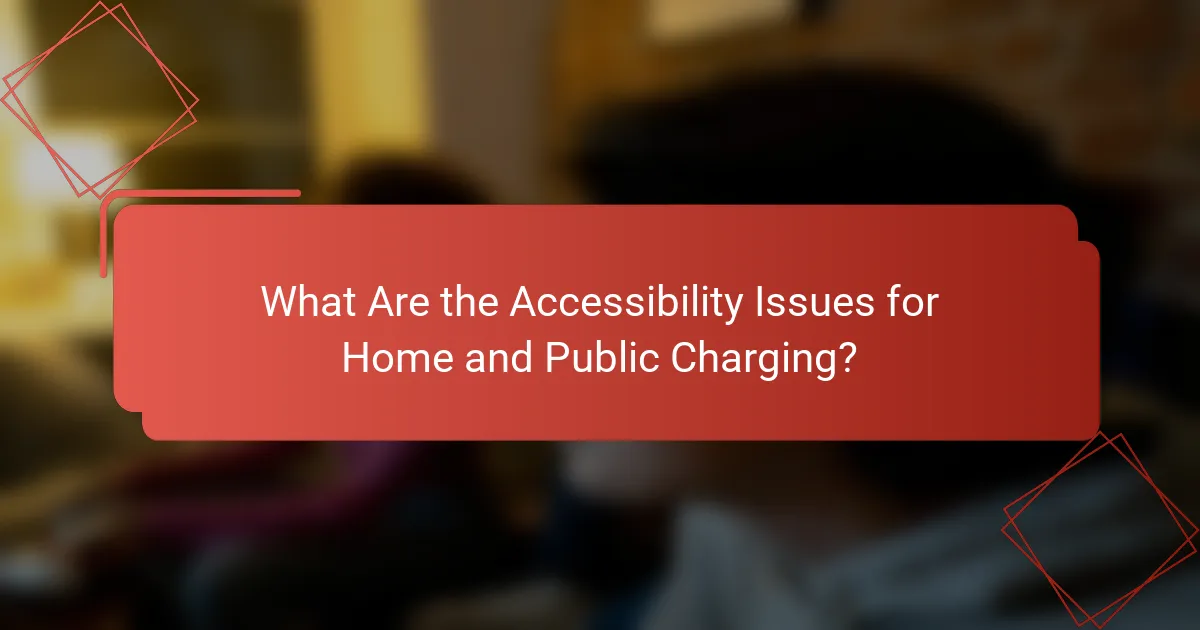
What Are the Accessibility Issues for Home and Public Charging?
Accessibility issues for home and public charging primarily revolve around the availability of charging infrastructure and the ability of users to access these facilities. Factors such as property ownership, location, and compliance with regulations can significantly impact the ease of charging for electric vehicle (EV) owners.
Home charging accessibility for renters
Renters often face challenges when it comes to home charging accessibility. Many rental properties do not have dedicated parking spaces or the ability to install charging stations, limiting renters’ options for convenient charging at home. Additionally, landlords may be hesitant to allow modifications to the property, which can further complicate access.
For renters interested in home charging, exploring options like shared charging stations or portable chargers can provide alternative solutions. It’s essential to discuss potential charging arrangements with landlords and consider the feasibility of installing a charging unit.
Public charging station accessibility for all EVs
Public charging station accessibility varies significantly based on location and the types of EVs supported. Some stations may only accommodate specific models or charging standards, which can limit options for certain users. It’s crucial for EV owners to research available charging stations to ensure compatibility with their vehicles.
Using apps or websites that provide real-time information on charging station availability can enhance the experience. Many of these platforms allow users to filter by charging speed and connector type, making it easier to find suitable stations.
ADA compliance of charging stations
ADA compliance is vital for ensuring that charging stations are accessible to individuals with disabilities. Many public charging stations are required to meet specific accessibility standards, including proper signage, clear pathways, and adequate space for wheelchair access. However, compliance can vary widely among different locations.
When seeking charging stations, users should look for those that explicitly state ADA compliance. This can help ensure a more inclusive experience for all EV owners, regardless of physical ability.
Geographical distribution of public charging
The geographical distribution of public charging stations can greatly affect accessibility for EV users. Urban areas typically have a higher concentration of charging stations, while rural regions may have limited options. This uneven distribution can lead to range anxiety for EV owners traveling in less populated areas.
To mitigate this issue, EV owners should plan their routes in advance, identifying charging stations along the way. Utilizing charging station locator tools can help find available options, especially in areas where public charging is sparse.
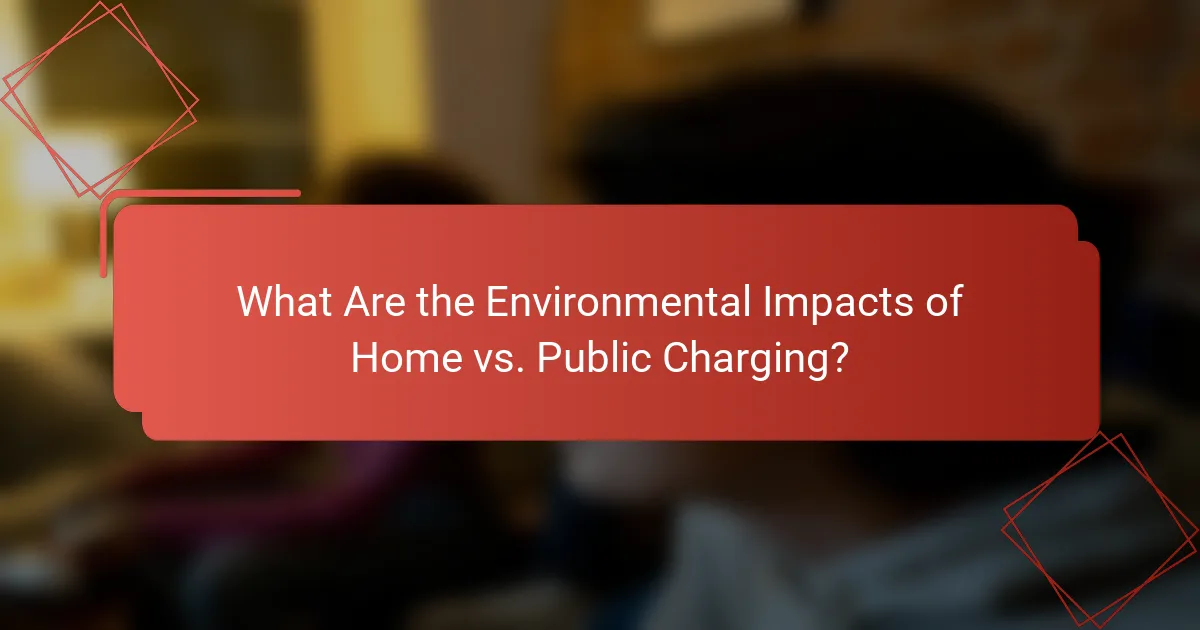
What Are the Environmental Impacts of Home vs. Public Charging?
The environmental impacts of home and public charging for electric vehicles (EVs) vary significantly based on energy sources and usage patterns. Home charging typically relies on the local grid, while public charging stations may utilize renewable energy, affecting overall carbon emissions and sustainability.
Home charging reduces grid strain
Home charging can help reduce strain on the electrical grid, especially during off-peak hours when energy demand is lower. By charging at night or during less busy times, EV owners can take advantage of lower energy rates and contribute to a more balanced load on the grid.
Additionally, many regions offer incentives for home charging installations, which can further promote the use of renewable energy sources. This can lead to a more sustainable energy ecosystem as homeowners invest in solar panels or other green technologies.
Public charging can use renewable energy
Public charging stations often have the potential to utilize renewable energy sources like solar or wind power. This can significantly lower the carbon footprint associated with charging, especially in areas where the grid is heavily reliant on fossil fuels.
Some charging networks are committed to sourcing 100% renewable energy, allowing EV owners to charge their vehicles in an environmentally friendly manner. However, the availability of such stations can vary widely by location, so it’s essential to research local options.
Carbon footprint of charging methods
The carbon footprint of charging methods can differ based on the energy mix of the local grid. Home charging may have a higher carbon impact in regions where coal or natural gas is predominant, while public charging stations that use renewable energy can significantly reduce emissions.
To minimize the carbon footprint, EV owners should consider charging during times when renewable energy is abundant, such as during sunny or windy days. Additionally, utilizing apps or platforms that provide information on the energy sources of public charging stations can help make more sustainable choices.
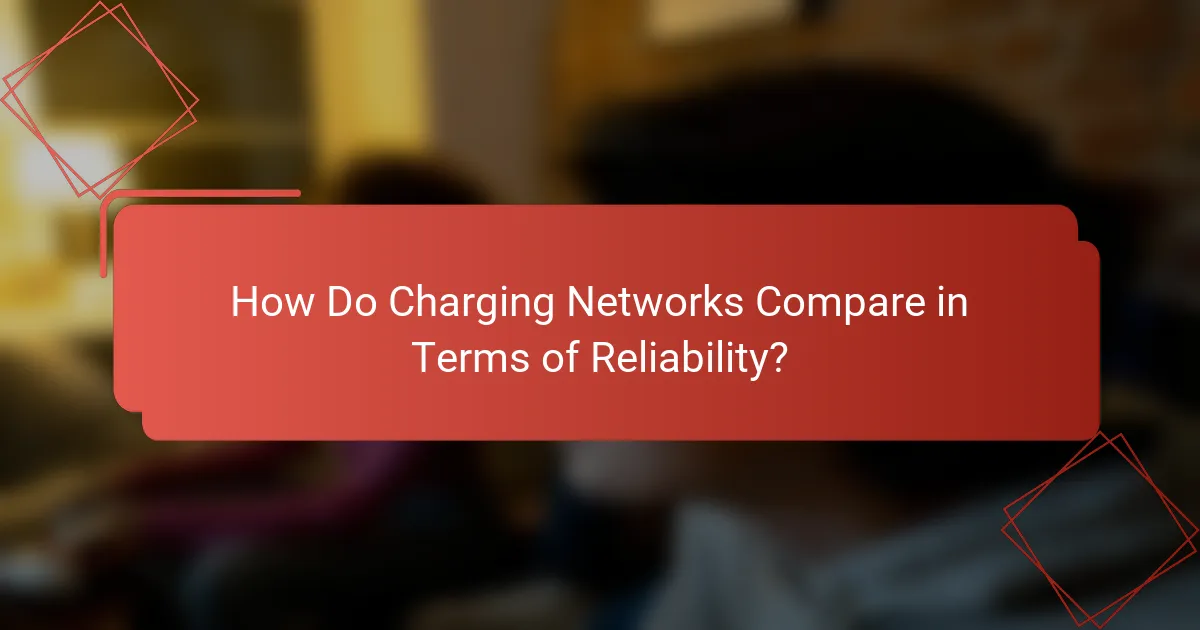
How Do Charging Networks Compare in Terms of Reliability?
Charging networks vary significantly in reliability, affecting user experience and convenience. Home charging setups typically offer consistent performance, while public charging stations can experience variability in availability and functionality.
Reliability of home charging setups
Home charging setups are generally very reliable, as they are installed in a controlled environment. Most homeowners can expect their Level 2 chargers to function consistently, providing a full charge overnight or during the day, depending on usage patterns.
To ensure reliability, it is essential to have a dedicated circuit for the charger and to regularly maintain the equipment. This minimizes the risk of electrical issues and ensures optimal charging speeds.
Public charging network reliability ratings
Public charging networks vary in reliability ratings, often influenced by the provider’s infrastructure and maintenance practices. Some networks are known for high uptime and user-friendly interfaces, while others may have frequent outages or poorly maintained stations.
Users can check online resources and apps that provide real-time data on station availability and reliability ratings. This can help in selecting a charging network that meets their needs, especially during long trips.
Common issues with public charging stations
Common issues with public charging stations include equipment malfunctions, long wait times, and insufficient charging speed. Users may encounter broken chargers or stations that are out of service, leading to frustration and delays.
Additionally, some public stations may not support all vehicle types, limiting accessibility. It’s advisable to plan charging stops in advance and to have backup options in case a chosen station is unavailable.
